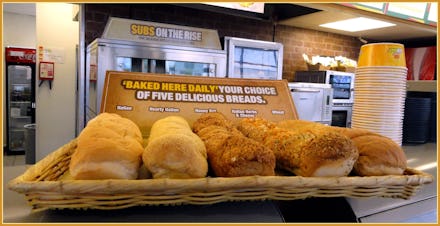These 5 Disgusting Ingredients Were Approved For Your Consumption by the FDA

Subway is generally thought of as healthy fast food, even with new ingredients like Fritos and Sriracha sauce, and the fact that its bread is full of a controversial chemical, azodicarbonamide.
A blogger, Vani Hari of "Food Babe," originally outed the fast food chain for using it and launched an online petition calling for its removal. Azodicarbonamide, which is also used to make yoga mats and shoe rubber, is banned in other countries because it is linked to respiratory issues, allergies and asthma. Subway says it was planning to get rid of the chemical before the petition started circulating online.
The chemical also appears in breads at other fast food chains like Wendy's, McDonald's and Starbucks because of its ability to pass off cheap, chemically-processed food as "freshly baked" by recreating a perfect, dough-y texture. The U.K., Europe and Australia consider it harmful and have banned azodicarbonamide as a food additive.
Hari put Subway on blast for promoting eating "fresh" while serving up a chemical that once led to an evacuation; when a truck carrying the chemical overturned on a Chicago highway in 2001, it prompted city officials to issue the highest hazardous materials alert and evacuate people within a half-mile radius.
It's chemicals like that that are driving up cancer rates. Which leads one to wonder, what other FDA-approved but downright-disgusting additives are being put in our food?
1. Propylene glycol
This preservative, which acts as a humectant, emulsifier and thickening agent, is found in everything from chewing gum to cheeses, salad dressing and soft drinks (always check the ingredients!).
Why is it gross? This petroleum-based food additive is also found in brake fluid, acrylic paints, tile grout, primer, shoe polish, floor polish and is a main ingredient in antifreeze.
Symptoms that can arise from relatively small doses include throat irritation, headache, backache and kidney problems. Doesn't sound too tasty, does it?
Editor's Note (Feb. 16, 2014): This image has been updated from the original version of this article published on Feb. 6.
2. Castoreum
Ever wonder what "natural ingredients" really means? One such natural ingredient is a flavor additive called castoreum, commonly found in vanilla or raspberry flavoring. It's not harmful and it's definitely natural — it's made from beavers' castor sacs, or anal scent glands that produce potent secretions that animals use to mark their territory in the wild.
About 1,000 pounds of castoreum are used annually in the food industry to flavor food with a distinctive, musky flavor.
3. TBHQ
This butane-based chemical preservative, called tertiary butylhydroquinone, is used in food to extend shelf life. It's found in Eggo waffles, Reese's Peanut Butter Cups, fast food, pet food, cosmetic skincare products, varnish and lacquers.
Consuming high doses can aggravate ADHD symptoms, and have been linked to cancer and DNA damage.
When it was revealed as an ingredient in Chik-fil-A sandwiches last year, the company decided to test a new recipe free of TBHQ in about 200 of its 1,700 locations, before potentially rolling it out chain-wide by the end of this year.
4. Dimethylpolysiloxane
Dimethylpolysiloxane is in Diet Coke, Sprite, Dr. Pepper and Fanta. It's also found in Chik-fil-A sandwiches, McDonald's fries, Domino's bread sticks, Taco Bell cinnamon twists and more.
But this is an especially disturbing ingredient because of the dizzying range of non-food products it is found in — breast implants, aquarium sealants, mold release agents, adhesives, cosmetics, polishes and hair conditioners are just a few examples.
5. Caramel coloring
Soda companies use caramel coloring to give that distinctive golden or deep brown color to colas, but some contain carcinogenic compounds like 4-methylimidazole, or 4-MI.
When 4-MI was found in samples of Coke, the company ended up switching to a low 4-MI formulation of caramel coloring to avoid having to place cancer warning labels on its sodas, which is required by California law since 4-MI was added to the state list of known carcinogens in 2011.
Previous studies have found that long-term exposure to this chemical caused lung cancer in mice.
Some beers, like Newcastle, also contain caramel coloring. Since the FDA doesn't require beer companies to disclose exact ingredients, caramel coloring is conveniently left off of the label.